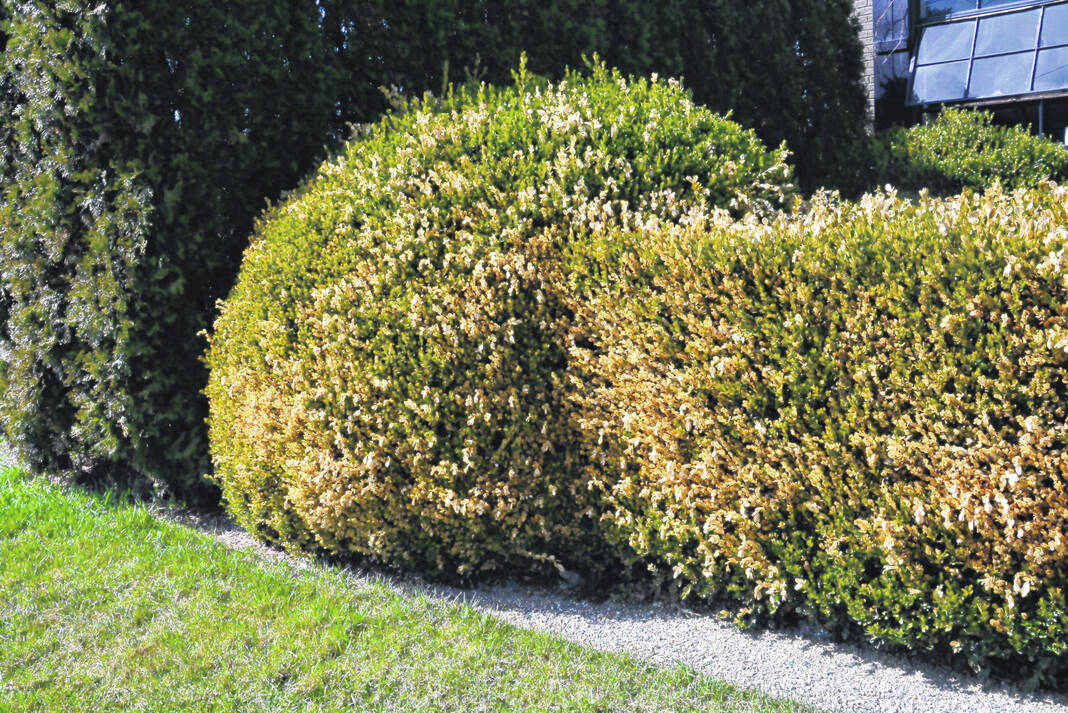

Diagnosing boxwood problems can be difficult because the symptoms are so similar.
Submitted photo
Boxwood, a popular evergreen shrub we’ve been planting for many years, is suddenly in the crosshairs. This reliable landscape mainstay is under attack from winter burn, a well-known insect, a non-native insect recently found in Ohio for the first time, and now a deadly disease. Pinpointing the culprit can be difficult because the symptoms are so similar.
Winter injury on boxwoods, caused by extremely cold weather last December, was widespread in spring 2023. Boxwoods typically recover from winter injury, so if dead branches are selectively pruned, new growth will eventually fill in the dead areas.
Boxwood leafminers lay eggs in Boxwood leaves. When the eggs hatch in early summer, the larvae feed on the inside of leaves all summer and again in spring, when the affected leaves turn brown. Leafminer damage from Boxwood leafminer looks very similar to winter injury. Insecticides containing imidacloprid or dinotefuran can control this problem.
Box Tree Moth has been found in southwest Ohio near the borders of Hamilton and Clermont Counties. This is the first time this non-native pest of boxwood has been confirmed in Ohio. Box tree moth caterpillars damage boxwood by devouring leaves. They can strip off all the leaves from affected plants. Box tree moth caterpillars develop into very distinctive brown and tan-colored moths. They can be controlled with Pyrethroid insecticides (those where the active ingredient ends in thrin, for example cyfluthrin, permethrin, resmethrin, cypermethrin, lamba-cyhalothrin, sumithrin), sprayed twice a year in late July and early September.
Volutella Blight symptoms often appear in early spring and are commonly mistaken for winter injury. It is more common but less damaging than Boxwood blight. It’s often called “canker” due to stem infections, which do not occur with boxwood blight. The leaves on cankered stems turn yellow to yellowish-brown and remain attached to the stems for an extended period. Volutella blight can be controlled by spraying at two-week intervals during spring and early summer with copper fungicide, chlorothalonil (Daconil), mancozeb, maneb, or thiophanate methyl. Cankered stems can be pruned out, promoting plant recovery.
Boxwood blight, a disease that causes severe and very rapid defoliation and branch dieback on some boxwoods, was first detected in Ohio four years ago. It can kill small plants in a single season. Gardeners may submit samples from suspect plants to Ohio State University’s Plant and Pest Diagnostic Clinic (ppdc.osu.edu) for diagnosis. Boxwoods infected with boxwood blight rarely recover and typically must be removed from the landscape, destroyed, and replaced with less susceptible varieties.
Boxwood blight is the most dangerous to your plants. Fungus spores can spread quickly under humid/wet conditions. The sticky spores cling to any dog, bird, insect, or person brushing past, and then spread to healthy plants. Rain, irrigation water, contaminated tools and workers all can quickly spread the pathogen from plant to plant. New infection begins in mid-to-late summer as dark circular spots on the newest foliage, which grow over time into a concentric ring pattern. The spots can then merge, forming lesions that take up a large portion of the leaf, causing it to die and drop off. Stems can get black streaks, and white fungal structures appear on stems and the undersides of leaves.
Proper sanitation is the best management strategy for boxwood blight. If you catch the infection during the early stages, you can simply cut the infected stems back until they are brown on the outside and vivid green beneath the bark. First, remove the infected areas to stop the disease from spreading. You must do this during a dry period, because rain will spread the disease rapidly. Cut it back a little below the infected area. Clean up all the trimmings and any dead leaves on the ground, burn them or seal them in trash bags. Sanitize any tools that you use with a 1:9 bleach to water mixture, and wash clothing that comes into contact with infected plants.
You may be able to control boxwood blight on healthy foliage by spraying a chlorothalonil-based fungicide (like Bonide Fung-onil, Daconil or Bravo) every 7 to 14 days, and after it rains. Use this fungicide carefully according to the label directions.
If your boxwoods are already badly damaged, it might be easiest (and definitely less expensive) to remove the whole plant, including any soil touching the roots. The disease is easily spread via tools, clothing or other equipment that comes in contact with the pathogen’s spores, so it is important to sanitize tools and avoid working with healthy boxwoods after working with infected ones.
Don’t Give Up on Boxwoods; they are very important in landscape design. Boxwoods are often the “backbone” of landscape designs because of their hard-to-match appearance, drought tolerance and deer resistance. There are hundreds of boxwood varieties, and they vary widely in blight resistance. Some are highly tolerant while others are highly susceptible. An online search for “blight-tolerant boxwoods” will help guide you.
Steve Boehme is a landscape designer/installer specializing in landscape “makeovers”. “Let’s Grow” is published weekly; column archives are online at www.goodseedfarm.com. For more information call GoodSeed Farm Landscapes at (937) 587-7021.

